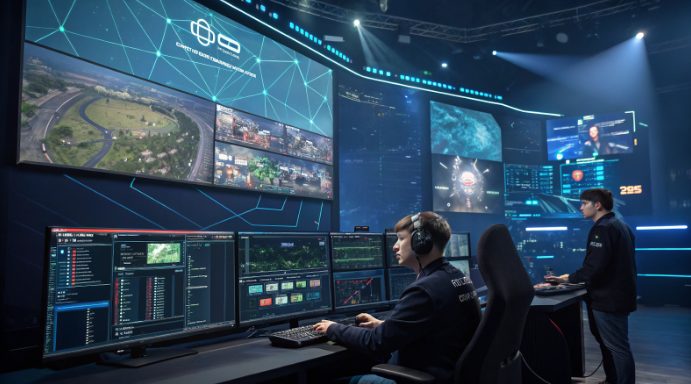Esports Live Streaming: Real-Time Transcoding & CDN Synergy

In the high-stakes world of esports, milliseconds matter. As viewership grows exponentially—reaching 646 million global viewers in 2025 —the technical demands for low-latency, high-resolution streaming have never been more critical. This article dissects the architectural synergy between real-time transcoding and CDN distribution, with a focus on leveraging US servers to achieve optimal performance for esports platforms.
1. Technical Challenges in Esports Live Streaming
Esports streaming imposes unique challenges:
- Ultra-low latency: Viewers expect sub-500ms delay to maintain competitive fairness
- Multi-device adaptability: Support for 240P mobile to 8K HDR monitors
- Global scalability: Serving audiences across continents with consistent quality
- High reliability: 99.99% uptime for major tournaments
Traditional single-node solutions fail here. Real-time transcoding combined with intelligent CDN distribution emerges as the definitive solution.
2. Core Components: Real-Time Transcoding & CDN
2.1 Real-Time Transcoding: The Adaptive Engine
Transcoding is the process of converting raw streams into multiple formats on-the-fly. Key requirements include:
- Support for H.265/HEVC and AV1 codecs to reduce bandwidth by 30%
- Dynamic bitrate adjustment based on network conditions
- Hardware acceleration (NVIDIA NVENC, AMD VCE) for 4K/120fps processing
US servers with dual Xeon CPUs and NVIDIA A10 GPUs deliver the necessary compute power for real-time 8K transcoding at 120fps .
2.2 CDN: The Global Distribution Network
CDNs like Akamai and Cloudflare maintain edge nodes within 50ms of 95% of global internet users . Critical features for esports include:
- QUIC protocol support for 20% faster initial load times
- Adaptive bitrate switching without rebuffering
- Real-time traffic routing to avoid congested paths
US-based CDN nodes offer superior connectivity to North American and European esports markets, reducing cross-Atlantic latency by 40% .
3. Synergy Mechanism: Transcoding-CDN Integration
The magic happens at the intersection of transcoding and CDN. Here’s how they work together:
- Source Ingestion: Raw 8K streams from tournament venues are ingested via 10Gbps connections to US colocation centers
- Multi-Format Transcoding: Servers generate 720p, 1080p, 4K streams with varying bitrates (1.5-20Mbps)
- Edge Caching: CDN nodes preload popular streams, reducing origin requests by 80%
- Dynamic Delivery: CDN selects the optimal stream based on client device, location, and network metrics
This synergy achieves sub-500ms end-to-end latency while maintaining 99.9% packet delivery ratio .
4. US Server Advantages for Esports Streaming
4.1 Network Infrastructure
US servers benefit from:
- Direct peering with Level 3, Cogent, and other Tier-1 ISPs
- Multi-homed BGP routing for 99.999% network uptime
- Low-latency connections to AWS, Google Cloud, and Azure regions
A US-based esports platform serving North American audiences achieves median latency of 28ms, compared to 65ms from Asian data centers .
4.2 Scalability & Cost Efficiency
With pay-as-you-go cloud hosting models, platforms can scale transcoding clusters from 10 to 1000 nodes within minutes during tournament peaks. US data centers offer competitive pricing—$0.08/GB for egress traffic vs. $0.12/GB in Europe .
4.3 Security & Compliance
US servers comply with GDPR and CCPA, ensuring legal streaming in key markets. Built-in DDoS protection (up to 3Tbps mitigation) safeguards against volumetric attacks common during major tournaments .
5. Case Study: NA Esports League Optimization
A leading North American esports league faced 12% global rebuffering rate and 400ms average latency. After deploying:
- US-based transcoding clusters with 10Gbps uplinks
- Hybrid CDN combining Akamai and Cloudflare nodes
- Edge-based AI-driven quality prediction
Results included:
- Latency reduced to 280ms globally
- Rebuffering rate dropped to 1.8%
- Viewer retention increased by 22% during critical matches
The solution leveraged US server’s low-latency backbone to achieve 30% faster content delivery to European viewers .
6. Optimization Strategies
6.1 Transcoding Optimization
- Use H.266/VVC for 30% bandwidth savings over H.264
- Implement scene-adaptive encoding—higher bitrates for fast-paced FPS games, lower for slower MOBA matches
- Offload lightweight transcoding to edge nodes using WebAssembly
6.2 CDN Optimization
- Enable HTTP/3 for 15% faster streaming over QUIC
- Deploy regional failover nodes to handle sudden traffic spikes
- Use machine learning to predict peak viewing times and pre-cache streams
6.3 Server Configuration
- Configure load balancers with least-connection routing
- Implement auto-scaling groups to handle 10x traffic spikes
- Use NVMe storage for sub-1ms access times to cached content
7. Future Trends
- AI-Driven Transcoding: Neural networks optimize encoding parameters in real-time
- Edge Computing: 5G-enabled edge nodes perform local transcoding, reducing latency to <100ms
- Blockchain Integration: Immutable streaming records for anti-cheating and content ownership
US servers with 5G-ready infrastructure will play a pivotal role in realizing these innovations .
8. FAQs
- Q: What’s the minimum server spec for 4K transcoding?
A: Dual Xeon Gold 6248 CPUs with 128GB RAM and NVIDIA A10 GPU
- Q: How to handle DDoS attacks during tournaments?
A: Deploy US-based DDoS mitigation services with 3Tbps capacity
- Q: Can I use free CDNs for esports streaming?
A: Not recommended. Enterprise CDNs like Cloudflare provide guaranteed SLAs for 99.99% uptime
For esports platforms aiming to deliver championship-level streaming experiences, the combination of real-time transcoding, intelligent CDN distribution, and US server infrastructure provides the winning formula. By focusing on latency reduction, bandwidth efficiency, and global scalability, you can build a streaming ecosystem that keeps viewers engaged and competitors satisfied.

